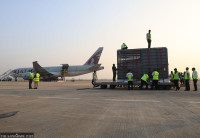Lumbini Province
Archaeologists begin excavation, exploration of historic Chetradeikot
Archaeologists from Department of Archaeology, Lumbini Development Trust and Durham University in UK commence work at the historically and archaeologically important fort in Lumbini.
Manoj Paudel
A team of archaeologists has begun excavation and exploration works at Chetradeikot in Buddhabhoomi Municipality-10, Kapilvastu this week.
The archaeologists from the Department of Archaeology, the Lumbini Development Trust and Durham University in the UK have commenced the excavation work at Chetradeikot, a historically and archaeologically important fort, by using modern technological tools.
Trenches have been dug in three different places on the premises of the fort as per a geophysical survey conducted in the area in 2020. The geophysical survey had revealed the existence of walls and ruins of temples or buildings.
Chetradeikot lies around one kilometre west of Tilaurakot, an ancient Shakya capital city where Siddhartha Gautam spent his princely life before he became the Buddha. It spreads in five bighas of land which is under the Department of Archaeology.
A 5m long and 1.5m wide trench has been dug at the premises of Chetradeikot for exploration. According to Himal Uprety, chief archaeological officer at the Lumbini Development Trust, Indian archaeologist PC Mukherjee had unearthed the same place in 1899 and recovered walls dating back to the 7th Century.
“The place where Mukherjee excavated is also included in the project,” said Uprety. According to him, various goods like coals, bricks, metals and soil recovered during the excavation have been collected for carbon dating.
It is expected that the fresh excavation will be helpful in determining the time period and structures of ancient Chetradeikot.
“Chetradeikot is near the Shakya capital Tilaurakot. It can be a temple of the Shakya dynasty,” said senior archaeologist Basanta Bidari. According to him, Mukherjee’s report states that the ruins of two temples and three wells were recovered from Chetradeikot during his excavation in 1899.
“Several historic pieces of evidence have been recovered while excavating Tilaurakot and its surrounding areas. Evidence is being collected from Chetradeikot as well that confirms its link with the historic Tilaurakot. The excavation and exploration work of Chetradeikot will be helpful to enlist Tilaurakot in UNESCO's world heritage list,” said archaeologist Ram Bahadur Kunwar, who is also the planning unit chief at the Department of Archaeology.
The Department of Archaeology and Lumbini Development Trust started excavating and exploring Tilaurakot and its surrounding areas in 2012.
The archaeologists believe that the excavation and exploration at Chetradeikot will be helpful for the conservation and management of places related to Budhha. According to Kunwar, the goods recovered during the fresh excavation at Chetradeikot will be properly studied.
A team of 28 people, including six archaeologists and students of Durham University, four archaeologists of the Department of Archaeology, two archaeologists from the Lumbini Development Trust, one Nepali consultant and students of Lumbini Buddhist University, is involved in the month-long excavation work.




 6.12°C Kathmandu
6.12°C Kathmandu












%20(1).jpg&w=300&height=200)

